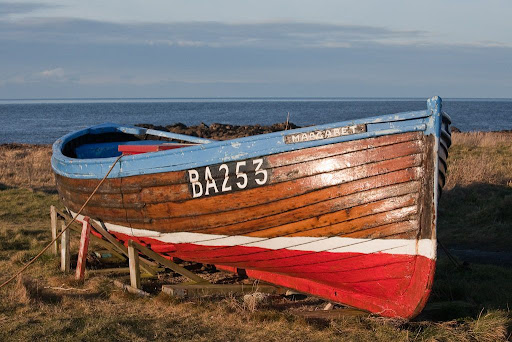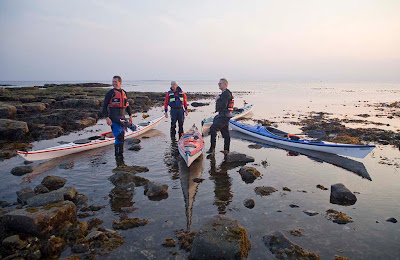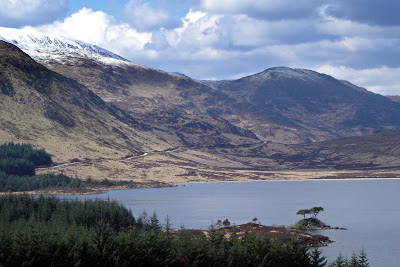Tuesday was a lovely day so Tony and I set off from Largs Marina...
...past the marine research station on Great Cumbrae island...
...and round Farland Point...
...where we passed this group of female eider ducks.
We entered the Tan between the Cumbraes and...
...landed on the Eileans for first luncheon.
We then set off for the Little Cumbrae Island trolling our fishing lines.
With the mountains of Arran in the distance, Phil caught us, he had been working all morning and had had no lunch!
We had noticed an unusual amount of VHF radio traffic. Then the MS Europa steamed majestically down the Clyde.
Fortunately for Phil, Tony caught three mackerel and I caught one, guess which one was mine!
We landed on the Little Cumbrae to cook them straight away. They didn't even have time to develop rigor mortis!
They were absolutely delicious! Then channel 16 on the VHF radios really started to buzz....
Imagine you are at the edge of the sea on a day when it is difficult to say where the land ends and the sea begins and where the sea ends and the sky begins. Sea kayaking lets you explore these and your own boundaries and broadens your horizons. Sea kayaking is the new mountaineering.
Showing posts with label fishing. Show all posts
Showing posts with label fishing. Show all posts
Friday, July 15, 2011
Friday, February 26, 2010
Off for the day to Ballantrae

On a Sunny February morning we went off for the day to Ballantrae. The name has Gaelic origins from Baile an Traigh, the village of the beach. It does have a very big beach. However, this name only dates back to 1617. Prior to that it was called Kirkcudbright Innertig. Apparently the Laird of Bargany who rebuilt the ancient Kirk of St Cuthbert at the mouth of the River Tig had a penchant for the Gaelic!

Behind the harbour you will find the Ballantrae registered (BA253) fishing boat Margaret. She was built in 1949 and is 6.55m long. She was still a registered and licenced fishing vessel until at least 2004 but any time I have visited Ballantrae recently, she has been well maintained but high and dry. As of February 2010 she is not registered.

The steep beach to the south of the harbour, where we have previously launched, is renowned for dumping surf. We chose instead the shelter of the harbour wall. Ballantrae is the most southerly village in Ayrshire and at one time its harbour would have been full of vessels fishing the offshore Ballantrae Banks for the herring which arrived in huge numbers every winter to spawn. Due to overfishing, the herring just about died out by the start of the 20th century. Nowadays BA registered boats are more likely to be based in Troon or Kirkcudbright harbours and be fishing for prawns or scallops.

Fifteen kilometers offshore the magnificent profile of Ailsa Craig dwarfed its lighthouse and looked tantalisingly close in the clear winter air.

But we were headed south to Ayrshire's wild Atlantic coast...

...and Tony wasted no time in putting the P&H Cetus LV through its paces on the way.
Sunday, October 25, 2009
Glassard and a wooly welcome to Scalasaig, Colonsay

We continued SE along Colonsay's coast line after leaving the abandoned fishing village of Riasg Buidhe. We came upon the planned township of Glassard (Glas Aird) to which, the former residents of Riasg Buidhe moved. Each new croft house had its own hay meadow and the men folk were able to use bigger fishing boats which were kept in nearby Scalasaig harbour.
A recent survey showed that Colonsay had 89 houses of which, 39 were holiday homes. Some of the Glassard crofts are now holiday homes or lets and gradually the old family links to Riasg Buidhe are being lost. Hay was last cut in Glassard over 15 years ago and now the meadows, with their profusion of wild flowers, are being invaded by bracken.

It was nearing time for second luncheon and we now approached the capital of Colonsay, Scalasaig, with some anticipation.

We paddled between the sheltering arms of Scalasaig's harbour and landed at a little beach at its head. The only fishing vessel currently registered with its home port as Colonsay is CN183 Sea Spray. She is a 7m wooden creel fisher built in 1960. You can just see her red hull at the back of the line of moored boats.

We walked up towards the main road and prepared to meet the locals. Would there be any formalities attached with our arrival? Would carnets need to be stamped?
We were met by a small welcoming committee, who were sheltering in the shade of what we presumed to be the custom house. They appeared to be taking a siesta, so we moved forward slowly to pass. Their leader cast a disdainful eye over our salt encrusted Goretex paddling gear but, without comment, slowly stood aside to let us through.
We had arrived in Scalasaig!
Monday, July 21, 2008
Of an Islay bothy, fishing rods and buoyancy aids.

After breaking out out of the tide we followed the coast and came across this wonderful bothy under scudding white clouds. Its remoteness has protected it from the vandalism that has afflicted many mainland bothies.

The view from the bothy door extended to the distant Mull of Kintyre.

This well equipped bothy has airbeds and a pump. It also has mask, snorkel and flippers and a fishing rod! On this occasion it was only 17:30 so we decided to press on further before making camp. We promised we would return! Both the estate and the MBA are due thanks for this wonderful place.

As we launched, David had dropped his rod into the sea just offshore. Fortunately he was wearing his dry suit and recovered it. It took several attempts as he forgot to remove his buoyancy aid. This must have made a deep impression as over the next four days Tony and I found several BA's, just like David's, on many beaches we stopped at. Usually just after David had paddled on!
12/07/2008
Friday, May 09, 2008
Busy night at Troon

We met last night at 8pm on the Ballast Bank at Troon Harbour on the Firth of Clyde.

Our destination was Lady Isle, a nature reserve to the SW.

Just as we set off the high speed ferry Express left for Larne in Northern Ireland. Her gross weight is 5902 tons and her maximum speed is 41 knots. She passes by Ailsa Craig and on our recent trip there we set off an hour later than we originally intended. This was to make sure she was well past the Craig before we arrived.

Those 4 diesels sure make some smoke as she warms up.

As she left the fishing fleet was returning to Troon. We had seen them scooping huge loads of fish from the waters round Ailsa Craig. I hope they have left enough for the gannets.
There are too many people on this Earth. Maybe we had all better become vegetarians before the food runs out but on the other hand, maybe its already too late.
08/05/2008
Monday, April 14, 2008
The hill tracks of Galloway and the harvest of the sea

From a distance it looks like the hill tracks of Galloway have a dusting of snow.

But as you walk or ride on the tracks, the crunch of this white covering is like no snow.

It is composed of tons of scallop shells which are a by product of the Kirkcudbright scallop fishing industry. There is no more space to dump them at the back of local farmers' fields, so they are now brought up here and dumped on the hill tracks. As the shells break down, the calcium carbonate might do something to reduce the effects of acid rain which has damaged the Galloway hill lochs.
Seeing the sheer number of scallop shells scattered on these hills, you realize just how big the scallop industry is. I know the Irish Sea is a big place but I do hope this proves to be a sustainable fishery.
13/04/2008
The following is an extract from SEPA View, issue 17 Autumn 2003 the magazine of the Scottish Environmental Protection Agency.
Evaluate use of waste scallop shells as road dressing to improve acidity in watercourses
Manager: Stuart Coy
Of 500km of fishless waters in Scotland, Galloway has 400km. Much of this relates to the extensive forest coverage in the area, which exacerbates acid rain. The trees filter out the acid and concentrate it, so when it rains the acidified water runs into the nearby watercourses. In many countries, lime has been successfully used to counteract acidity either by direct addition to water or application over the catchment land. However, this is an expensive and perhaps unsustainable procedure. As scallop shells are 95 per cent limestone in composition and the country’s largest processor of waste scallop shells, West Coast Sea Products, is situated in Galloway, an action plan was established to determine whether the shells could be used as a viable means of reducing levels of acidity in local watercourses. As waste, the shells must be disposed of in a manner that conforms with the exemptions laid out in the Waste Management Licensing Regulations 1994 which permits them to be used in road construction. Two methods are currently being employed. In the first, clean, crushed shells are incorporated into the sub-base aggregates, effectively burying them. The second, more appropriate use, is as a road surface dressing. In theory, the passage of vehicles will speed up the release of calcium.
SEPA Galloway team leader, Stuart Coy said: “This experimental use of shells is still very new to Galloway and the logistics of getting them from the factory to the forest in an acceptable condition are continuing to develop. If it can be made to work then it seems there will be benefits all round. “Should there be a reduction in the quarried aggregate required for road construction, the use of the shells in this way means that they will not be going to licensed landfill which would have cost around £100,000 for disposal. Ultimately, much-needed calcium will be released into acidified surface waters.”
Thursday, April 10, 2008
The fishermen of Kirkcudbright Harbour

The fishing fleet is in, bringing colour to Kirkcudbright Harbour.
Like Maidens, Kirkcudbright's fishing fleet declined during the first half of the 20th century. Then in the late 1950's a revival started after local man, John King, started lobster and scallop fishing. Gradually the number and size of the boats increased and construction changed from wood to steel. Today there is only one traditional wooden Scottish boat left. She is the "Fredwood" on the extreme right of the photograph. Most of the boats are scallop dredgers but "Argo", the small boat in the foreground, is a cockle dredger. One of the biggest boats is the blue boat, third from the right. She is the "King Explorer" and is part of the John King fleet.
A local economy has built round the fishing fleet; fish processing, dredging gear manufacturers, suppliers etc.. Local restaurants serve fresh scallops which make an excellent starter before a succulent grass fed Galloway fillet steak.

All this has come at a cost, in 1985 the "Mhari-L" was lost with all 5 hands. Then in 2000 the "Solway Harvester" was lost with all 7 hands. Both vessels were lost in the Irish sea between Galloway and the Isle of Man. On their way to the boats, fishermen walk past a memorial dedicated to the women and children of this and other Galloway fishing communities who have lost their menfolk.
22/03/2008
Saturday, March 15, 2008
Better Days #3

This old fishing boat has seen better days, her still stout timbers are now part of the sea.
In the county of Argyll, on Scotland's west coast, Loch Sween cuts deep inland from the tidal waters of the Sound of Jura. At its head, a dog leg leads into the hidden recesses of Caol Scotnish, a thin ribbon of the sea which penetrates deep into a land shrouded in mosses and oaks.

The shores are steep and rocky and the oaks lean over the sea dipping their leaves in salt water at high tide. We visited on a typical west coast day, the rain was running from leaf to leaf with the drips gathering in size as they went.

Wending our way under dipping and dripping branches we came across this forlorn old fishing boat.

She was just about as far from her old fishing grounds as was possible to get and still be in the realm of the sea. Now instead of her hull rising and falling over ocean swells, the tides rise and fall over her planking. Strands of bladder wrack are left hanging from her hull as the tide recedes.
Go on, get out there, enjoy your better days while you are able.
19/09/2004
Friday, March 14, 2008
Better Days #2

Maidens Harbour is protected from the sea by the rocky Maidens reef. In summer it is full of recreational boats but when a chill eastern wind blows in winter, only this old work boat lists and strains at her moorings. She is tethered with knotted scraps of rope and she is lying low in the water as her hull is flooded with rain and sea spray.
Despite her neglect she still floats, carrying the pride of the craftsmen who sweated her fine curves and lines from planks of stout wood and the men who fished her on stormy waters.
Those were better days, they were proud days.
09/02/2008
Tuesday, March 11, 2008
Better Days

We came across this old fishing boat near the shore of Loch Craignish. The flaking paint of her planking glowed in the twilight and brought colour to the waters of the loch that once supported her. She is alone now and her days at sea are past but she is decaying with a dignity that befits a craft that in turn supported a way of life.
Boats like this can be found in quiet corners all round the West coast of Scotland. They are a dying breed; built of wood by local craftsmen (this one perhaps in the boatyard at nearby Crinan) they sometimes served several generations of one fishing family. I wonder if the men who fished from her are still working or have long since retired. They too are a dying breed.
We left her in the gathering darkness of Craignish.
12/02/2008
Saturday, February 09, 2008
Hand dived scallops of Harris.

It was quite windy in Loch Reasort, a deep sea loch on the west coast of Harris in the Outer Hebrides. It was perhaps a little too breezy for sea kayaking.

So we went for a walk...

....while the divers went... diving in nearby Loch Tamnabhaigh.

They brought up a good haul of hand dived scallops. Recently StuartA commented "Maybe for hand-caught scallops? Yum!"

There is a worrying number of bits and pieces in there...

... but as Stuart said, Yum! (This photo Mike Marshall.)
12/06/2006
Monday, February 04, 2008
Work and play in Culzean Bay.

Leaving Culzean Castle, we continued NE across the sand rimmed Culzean Bay. We came across this catamarn fishing vessel. She is the Sea Venture and she has applied for membership of the Responsible Fishing Scheme. Although registered in Campbeltown, her home port is Carradale some 55km away, on the far side of Arran.

She was lying to two anchors and appeared to have been dredging for shell fish as the crewman was sorting his catch on a riddle. Possibly she was fishing for razor, shells though the sustainability of harvesting these slow growing bivalves in the Clyde and effect on other species is not yet established. Razor shells are seldom eaten in Scotland though they are in great demand in southern Europe.
We exchanged waves with the crewman as we passed. We left him hard at work on the riddle and we made our way north east to Dunure, where we had an appointment.
20/01/2008











